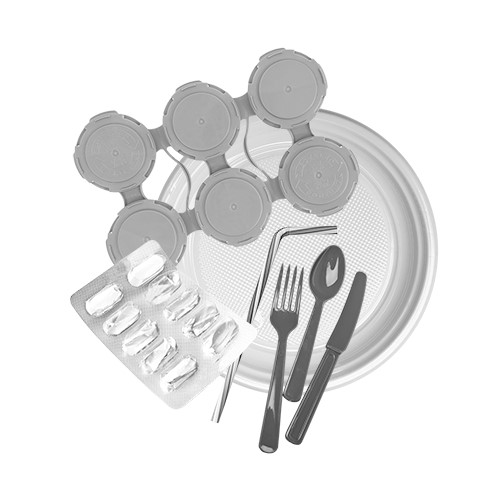
Utensils, Straws and Other Plastic
Do not place plastic plates, utensils, straws, plastic 6-pack rings, blister packaging, Styrofoam, buckets, pails in curbside recycling. Dispose in the trash.
Do not place plastic plates and utensils, straws, plastic 6-pack rings, blister packaging, Styrofoam, or durable plastic such as hangers, toys or pails, and buckets in curbside recycling.
There may be alternatives for reuse or recycling. If the item cannot be reused or recycled at a special drop-off, place it in the regular trash for disposal.
- NO Styrofoam packaging, Styrofoam cups, or Styrofoam food containers. The plastic has been expanded with air and is very fragile. It breaks apart into tiny pieces during the sorting process. See more about Styrofoam.
- NO prescription medication bottles including translucent orange, blue, and green colors. See details on the medications page.
- NO plastic coffee pods, plates, or utensils. See more about coffee pods.
- NO flowerpots. Plastic flowerpots, packs, flats, and agricultural plastic should be reused or placed in the trash for disposal. See more about flowerpots.
- NO plastic blister packaging.
- NO durable plastic, plastic hangers, rigid vinyl, or toys.
- NO cat litter buckets or 5-gallon pails. These items are too large to be included. Consider reuse before placing them in the trash.
- NO plastic 6-pack rings. Local breweries and beverage distributors, including Great Lakes Brewing Co., HiHO Brewing Co., Market Garden Craft Brewery, Masthead Brewing Co., Ross Beverage, Ross Wine & Liquor, Rozis Wine House, Saucy Brew Works, Sibling Revelry Brewing, Tansy Recycling, and The Wine Spot, accept PakTech can carrier rings and handles for recycling. There is a drop-off for PakTech carrier handles at the Solid Waste District. You can also use a free mail-back program for the rings. Rings made of film plastic should be placed in the regular trash.
- NO plastic bags, wraps, or netted produce bags. Bags will wrap around the gears, wheels, and automated sorting equipment machinery at the MRF and shut down the rcycling plant. It's similar to an item getting caught in the beater brush of your household vacuum. See more about plastic bags.
- NO empty bottles for hazardous materials such as motor oil, antifreeze, bleach, or ammonia. These containers may contain hazardous residue and should be placed in the trash, not recycling, for proper disposal.
What about other plastics? Can all plastics be recycled?
In Cuyahoga County, all communities can include plastic bottles or jugs in curbside recycling. The container should have a “neck” and have a diameter of 2" or more. Plastic bottles and jugs must be empty, clean, and dry. Drain excess fluid, replace the cap then recycle. See more about plastic bottles and jugs.
Some communities can also include clear plastic clamshells, plastic tubs, and plastic to-go cups in recycling.
See recycling information for your community by allowing location services or using the green ‘Select a City’ drop-down at the top of every page and clicking ‘See Details.’
What about those numbers on plastic containers? Does that mean the container is recyclable?
The numbers on plastic containers are resin identification codes used by the plastics industry to identify the type of resin used to make the container. All plastic containers have a code but it does not mean the item is recyclable. Developed by the plastics industry, the codes were never intended to be a consumer communications tool.
Why is recycling plastic so challenging?
There is an abundance of plastic packaging in our society today. Currently, about 9% of it can be recycled. This is due to limited markets for recycled plastic - not all manufacturers produce packaging from recycled plastic - and the complexities of sorting, processing, and recycling the various kinds of plastic.
Plastic is a synthetic (man-made) material. Most plastic material is a derivative of crude oil and natural gas, which are non-renewable resources. Plastic products are often a polymer resin mixed with a blend of additives.
Plastic products are created through thermoforming and blow molding. Earth911 explains the differences between the processes including how they are chemically different and melt at different temperatures, and how that affects recyclability.
Most plastic placed in curbside recycling bins is downcycled. This means it is turned into lower-quality products such as fibers for clothing, carpeting, polyfill in pillows, winter coats, and other goods. Only a small percentage is recycled into new bottles and containers. Read more about downcycling.
NPR published a project in 2019 that explains plastic recycling.
What are our alternatives?
We can choose to reduce our consumption of single-use plastic. Small changes add less plastic waste to our landfills and our environment. Consider these ideas for reducing waste.
Until there is a major shift in the demand for recycled plastic and more sensible packaging design, consumers are limited in our recycling options.
---
Looking to recycle, donate, or dispose of other items? Use the dark blue 'What Do I Do With?' search bar at the top of every page of this website. Allow location services or use the city drop-down to find opportunities in your local area.
